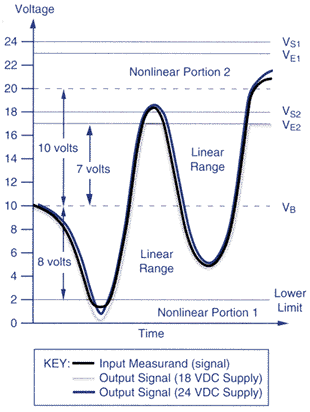Main Menu
- Home
- Product Finder
- Calibration Systems
- Calibration Services
- Digital Sensing
- Industrial Vibration Calibration
- Modal and Vibration Testing
- Non-Destructive Testing
- Sound & Vibration Rental Program
- Learn
- About Us
- Contact Us
New users of piezoelectric (PE) type accelerometers are always fascinated with the concept of zero biased response. Maybe it’s the general prevalence of slow speed, static type measurements, or maybe it’s the dominance of “mechanical oriented” people in the vibration test/measurement field, but AC coupled operation is always a question of early intrigue. The discussion of AC coupling, discharge time constants (DTC) and system operation inevitably follows.
The microelectronic field effect transistor (FET) is the fundamental mechanism by which the high impedance signal from the PE crystals is converted to the low impedance (normally less than 100 ohms) signal for input to the typical digital data acquisition system. The FET is supplied a DC excitation voltage through a constant current diode. This excitation voltage powers the electronics and provides the DC bias voltage on which the accelerometer’s AC signal rides to swing both positively and negatively.

Prior to exiting the signal conditioning stage, a blocking capacitor is used to remove the bias voltage. The blocking capacitor and companion resistor tied to ground form an RC network functioning as a high pass filter. The roll off characteristic of this single 2 pole filter can be described by a Discharge Time Constant (DTC). The DTC can be used to calculate the corner frequency where the amplitude decays 3 dB. Accelerometers are typically specified for low frequency operation as by defining the low frequency point which still provides flat amplitude response to within 5% or 10% of the reference frequency amplitude. Since frequency response amplitudes continue to roll off very rapidly and deviate from the nominal reference calibration value as frequencies approach the DTC corner frequency, many users verify their accelerometer’s low frequency performance with a low frequency calibration option to their calibration. Low frequency options to calibration systems add hardware and software to handle the special considerations for increasing displacement at very low frequencies and increasing resolution/lowering the noise of the reference sensor. The constant current signal conditioner also has a DTC which can affect the low frequency response if not sufficiently longer than the DTC of the accelerometer. We’ll cover more on that in a future edition.
Change in the DTC can be indicative of problems such as loss of hermeticity in the sensor welds or the connector glass insert seal. As such, monitoring the DTC by a simple flip test is a less involved method of checking the health of an accelerometer. The flip test quickly inverts the sensor, applying a 2 g step input (+1 g static input to -1 g static input) to then capture the sensor output as the bias level decays back to zero. A simple exponential fit to the data provides an estimate of the discharge time constant. This can be compared to the manufacture data from original or last calibration which is usually specified in terms of greater than some number of seconds (typically in the few seconds range).